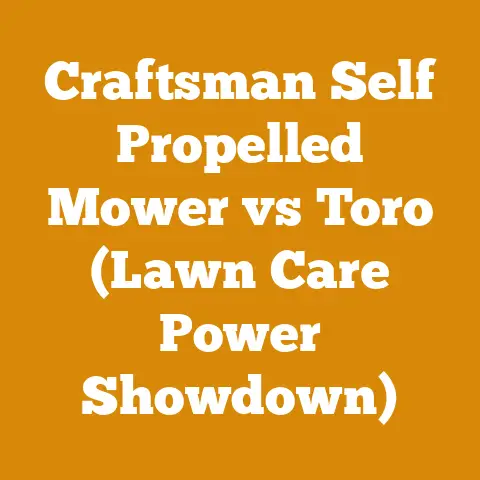Wood-Mizer Log Splitter Review (5 Pro Tips for Heavy-Duty Use)
Taming the Beast: Noise Reduction and the Wood-Mizer Log Splitter
One of the first things you’ll notice when you start splitting wood, especially with a hydraulic log splitter like a Wood-Mizer, is the noise. It’s a consistent hum and whir, punctuated by the crack of splitting wood. This can be particularly problematic if you’re working in a residential area or have neighbors close by. I remember one of my early experiences splitting wood for a winter, and the constant noise drew some unwanted attention. It taught me the importance of noise mitigation.
Why Noise Reduction Matters
Beyond neighborly relations, prolonged exposure to loud machinery can lead to hearing damage. Furthermore, a quieter work environment is simply more pleasant and less fatiguing. Before diving into the specifics of the Wood-Mizer log splitter, let’s address the elephant in the room – noise.
1. Location, Location, Location
The first and often simplest step is to choose your splitting location wisely.
- Distance: The further you are from dwellings, the better. Sound dissipates with distance.
- Natural Barriers: Utilize natural barriers like hills, dense vegetation, or existing buildings to absorb sound.
- Orientation: Position the splitter so that the engine exhaust and hydraulic pump noise are directed away from sensitive areas.
2. Sound Dampening Materials
Applying sound-dampening materials to the splitter itself can significantly reduce noise.
- Engine Compartment: Line the engine compartment (if applicable) with acoustic foam or sound-deadening mats. Be sure to choose materials that are heat-resistant and won’t pose a fire hazard.
- Hydraulic Pump: The hydraulic pump is a major source of noise. Consider wrapping it with a sound-dampening blanket specifically designed for hydraulic equipment.
- Frame and Chassis: Applying vibration-damping materials to the frame and chassis can reduce the transmission of vibrations and noise.
3. Hydraulic Fluid Considerations
The type of hydraulic fluid you use can also impact noise levels.
- Viscosity: Higher viscosity fluids tend to dampen vibrations and reduce noise compared to thinner fluids. Consult your Wood-Mizer manual for the recommended hydraulic fluid type and viscosity.
- Anti-Foam Additives: Ensure your hydraulic fluid contains anti-foam additives. Foaming in the hydraulic system can create cavitation, which generates excessive noise and can damage the pump.
4. Maintaining Your Splitter
Regular maintenance is crucial for keeping your splitter running quietly and efficiently.
- Hydraulic System: Check hydraulic lines and fittings for leaks. Air in the hydraulic system can cause cavitation and noise. Bleed the system regularly.
- Engine Maintenance: Ensure the engine is properly tuned and maintained. A poorly running engine will be louder and less efficient.
- Moving Parts: Lubricate all moving parts regularly to reduce friction and noise.
5. Personal Protective Equipment (PPE)
While not directly reducing the noise of the splitter, wearing appropriate PPE is essential for protecting your hearing.
- Entry-Level Models: These are typically smaller, more affordable splitters suitable for homeowners who process firewood occasionally. They often have lower tonnage ratings (around 20-25 tons).
- Mid-Range Models: These offer a balance of power and portability, ideal for those who split firewood more regularly or need to handle larger logs. Tonnage ratings range from 25-30 tons.
- Heavy-Duty Models: These are the workhorses of the Wood-Mizer lineup, designed for commercial firewood production or processing very large, dense logs. They boast high tonnage ratings (30 tons and above) and often feature more robust construction and faster cycle times.
Pro Tip 1: Choosing the Right Wood-Mizer Log Splitter for the Job
This seems obvious, but it’s a critical first step. Don’t buy a splitter that’s underpowered for the type of wood you’ll be splitting.
Matching Tonnage to Wood Type
The tonnage rating of a log splitter refers to the amount of force it can exert to split a log. The higher the tonnage, the larger and tougher the logs it can handle.
- Softwoods (Pine, Fir, Spruce): 20-25 tons is typically sufficient for splitting softwoods.
- Hardwoods (Oak, Maple, Hickory): 25-30 tons is a good starting point for hardwoods, but larger logs or particularly knotty wood may require 30 tons or more.
- Extremely Dense Hardwoods (Ironwood, Locust): 30+ tons is recommended for these woods, especially if you’re dealing with large diameters.
Cycle Time: Speed Matters
Cycle time refers to the time it takes for the ram to extend and retract. A faster cycle time means you can split more wood in less time.
- Occasional Use: Cycle time is less critical for occasional use.
- Regular Use: A cycle time of 15 seconds or less is desirable for regular use.
- Commercial Use: Look for a splitter with a cycle time of 10 seconds or less for commercial firewood production.
Horizontal vs. Vertical Splitters
Wood-Mizer offers both horizontal and vertical log splitters.
- Horizontal Splitters: Logs are loaded horizontally and pushed against the splitting wedge. These are generally easier to use for smaller logs.
- Vertical Splitters: Logs are placed vertically under the splitting wedge, which is then lowered onto the log. Vertical splitters are better suited for large, heavy logs that are difficult to lift.
Personal Anecdote
I once tried to save money by purchasing a smaller, 22-ton splitter. I quickly regretted it when I encountered a pile of seasoned oak logs. The splitter struggled, and I wasted a lot of time making multiple passes. I ended up upgrading to a 30-ton model, which handled the oak with ease. This experience taught me the importance of matching the splitter to the wood.
Pro Tip 2: Mastering the Art of Log Preparation
Proper log preparation is crucial for efficient and safe splitting. This involves bucking logs to the correct length, assessing them for knots and defects, and understanding the properties of different wood types.
Bucking Logs to the Right Length
The ideal log length for splitting depends on your stove or fireplace. Measure your firebox and subtract a few inches to allow for airflow.
- Common Firewood Lengths: 16 inches, 18 inches, and 20 inches are common firewood lengths.
- Accuracy is Key: Use a measuring tape and a chainsaw to buck logs to the desired length. Consistent lengths make stacking and burning easier.
Identifying and Addressing Knots
Knots are a common obstacle when splitting wood. They represent points where branches grew out of the tree, creating dense, interlocking grain.
- Assess the Knot: Examine the knot to determine its size and orientation.
- Split Around the Knot: If possible, position the log so that the knot is off-center. This allows the splitter to work around the knot rather than directly through it.
- Use a Wedge: For stubborn knots, use a splitting wedge and a sledgehammer to create a starting point.
- Accept Defeat (Sometimes): Some knots are simply too large or complex to split. In these cases, it’s best to set the log aside for use as kindling or for other purposes.
Understanding Wood Types
Different wood types have different splitting characteristics.
- Green Wood vs. Seasoned Wood: Green wood (freshly cut) is generally easier to split than seasoned wood (dried). However, seasoned wood burns more efficiently and produces less smoke.
- Straight-Grained Wood vs. Twisted-Grained Wood: Straight-grained wood splits easily along the grain. Twisted-grained wood is more difficult to split and may require more force.
- Resinous Wood vs. Non-Resinous Wood: Resinous woods (like pine) contain more sap, which can make them sticky and harder to split. Non-resinous woods (like oak) are generally easier to split.
Case Study: Taming a Twisted Oak
I once encountered a massive oak log with severely twisted grain. It was a real challenge. I started by carefully examining the log and identifying the areas where the grain was least twisted. I used a combination of splitting wedges, a sledgehammer, and strategic positioning on the splitter to gradually work my way through the log. It took time and patience, but eventually, I was able to split it into manageable pieces. The key was to respect the wood and work with its natural tendencies, rather than trying to force it.
Pro Tip 3: Optimizing Your Splitting Technique
The way you operate your log splitter can significantly impact its efficiency and your safety.
Safe Operating Procedures
Safety should always be your top priority when operating a log splitter.
- Read the Manual: Thoroughly read and understand the owner’s manual before operating the splitter.
- Wear PPE: Always wear safety glasses, gloves, and steel-toed boots.
- Keep Clear: Keep children and pets away from the work area.
- Stable Ground: Operate the splitter on a level, stable surface.
- Two-Handed Operation: Most log splitters require two-handed operation for safety. Never bypass this feature.
- Proper Posture: Maintain good posture and avoid overreaching.
- Emergency Stop: Know the location of the emergency stop switch and how to use it.
Efficient Splitting Techniques
- Positioning the Log: Position the log so that the splitting wedge aligns with the grain.
- Splitting on the Edge: If a log is too large to split in one pass, try splitting it on the edge first. This can create a weak point that makes subsequent splitting easier.
- Using a Four-Way Wedge: A four-way wedge splits the log into four pieces in one pass, significantly increasing efficiency. However, it requires more force and is best suited for straight-grained wood.
- Avoiding “Stuck” Logs: If a log becomes stuck on the wedge, do not try to force it. Retract the ram and try repositioning the log. If necessary, use a splitting wedge and a sledgehammer to free the log.
Personalized Advice
I’ve found that taking short breaks every hour helps prevent fatigue and maintain focus. Splitting wood can be physically demanding, and it’s important to listen to your body. Additionally, consider using a log lift or ramp to avoid heavy lifting, especially when dealing with large logs.
Pro Tip 4: Maintaining Your Wood-Mizer Log Splitter for Longevity
Regular maintenance is essential for keeping your Wood-Mizer log splitter running smoothly and extending its lifespan.
Scheduled Maintenance
Follow the manufacturer’s recommended maintenance schedule. This typically includes:
- Engine Oil Changes: Change the engine oil at the recommended intervals.
- Hydraulic Fluid Changes: Change the hydraulic fluid according to the manufacturer’s recommendations.
- Filter Replacements: Replace the engine air filter, fuel filter, and hydraulic filter regularly.
- Greasing: Grease all moving parts regularly.
- Spark Plug Replacement: Replace the spark plug as needed.
- Inspection: Inspect the splitter for any signs of damage or wear.
Hydraulic System Care
The hydraulic system is the heart of the log splitter. Proper care is essential.
- Check Fluid Levels: Regularly check the hydraulic fluid level and add fluid as needed.
- Inspect Hoses and Fittings: Inspect hydraulic hoses and fittings for leaks or damage. Replace any damaged components immediately.
- Bleed the System: Bleed the hydraulic system to remove air.
- Protect from Contamination: Prevent dirt and debris from entering the hydraulic system.
Engine Maintenance
If your Wood-Mizer log splitter is powered by a gasoline engine, proper engine maintenance is crucial.
- Fuel Stabilizer: Use a fuel stabilizer in the gasoline to prevent fuel degradation, especially during periods of storage.
- Clean the Engine: Keep the engine clean and free of debris.
- Adjust Valves: Adjust the engine valves as needed.
Case Study: Resurrecting a Neglected Splitter
A friend of mine inherited a Wood-Mizer log splitter that had been neglected for years. The engine was difficult to start, the hydraulic system was sluggish, and the splitter was covered in rust. We spent a weekend cleaning, repairing, and servicing the splitter. We changed the engine oil and filter, replaced the spark plug, cleaned the carburetor, changed the hydraulic fluid and filter, greased all moving parts, and touched up the paint. The result was a log splitter that ran like new. This experience demonstrated the importance of regular maintenance and the potential for restoring neglected equipment.
Pro Tip 5: Maximizing Efficiency and Productivity
Beyond the basics, there are several strategies you can employ to maximize your efficiency and productivity when splitting wood.
Optimize Your Workflow
- Staging Area: Create a staging area for logs waiting to be split.
- Sorting System: Implement a sorting system for split wood based on size and type.
- Efficient Stacking: Stack split wood in a way that promotes airflow and drying.
- Minimize Movement: Arrange your work area to minimize unnecessary movement.
Tool Organization
- Keep Tools Accessible: Keep splitting wedges, sledgehammers, and other tools within easy reach.
- Designated Storage: Designate a specific location for each tool to prevent loss and clutter.
Teamwork (If Applicable)
If you’re working with a team, assign specific roles and responsibilities.
- Log Loader: One person can be responsible for loading logs onto the splitter.
- Operator: Another person can operate the splitter.
- Stacker: A third person can be responsible for stacking the split wood.
Data-Driven Insights
Keep track of your production rate and identify areas for improvement.
- Time Studies: Conduct time studies to determine how long it takes to split a certain amount of wood.
- Identify Bottlenecks: Identify any bottlenecks in your workflow and address them.
- Track Fuel Consumption: Track fuel consumption to monitor the efficiency of your splitter.
Personalized Experience
I’ve found that listening to music or podcasts while splitting wood can help make the task more enjoyable and less monotonous. However, it’s important to be aware of your surroundings and maintain focus on safety. I also use a simple spreadsheet to track my production rate and fuel consumption. This helps me identify areas where I can improve my efficiency.
Strategic Advantages
By optimizing your workflow, organizing your tools, and leveraging teamwork, you can significantly increase your productivity and reduce the amount of time it takes to split wood. This translates to more firewood in less time, which can be especially important if you’re producing firewood commercially.
Next Steps: Putting Knowledge into Action
Now that you’ve absorbed these pro tips, it’s time to put them into action.
- Assess Your Needs: Determine the type and volume of wood you’ll be splitting.
- Choose the Right Splitter: Select a Wood-Mizer log splitter that’s appropriately sized for your needs.
- Prepare Your Logs: Buck logs to the correct length and assess them for knots and defects.
- Optimize Your Technique: Practice safe and efficient splitting techniques.
- Maintain Your Splitter: Follow the manufacturer’s recommended maintenance schedule.
- Maximize Efficiency: Implement strategies to optimize your workflow and productivity.
By following these steps, you can get the most out of your Wood-Mizer log splitter and enjoy years of reliable service. Remember, splitting wood can be a rewarding and enjoyable activity, but it’s important to prioritize safety and efficiency. Happy splitting!






